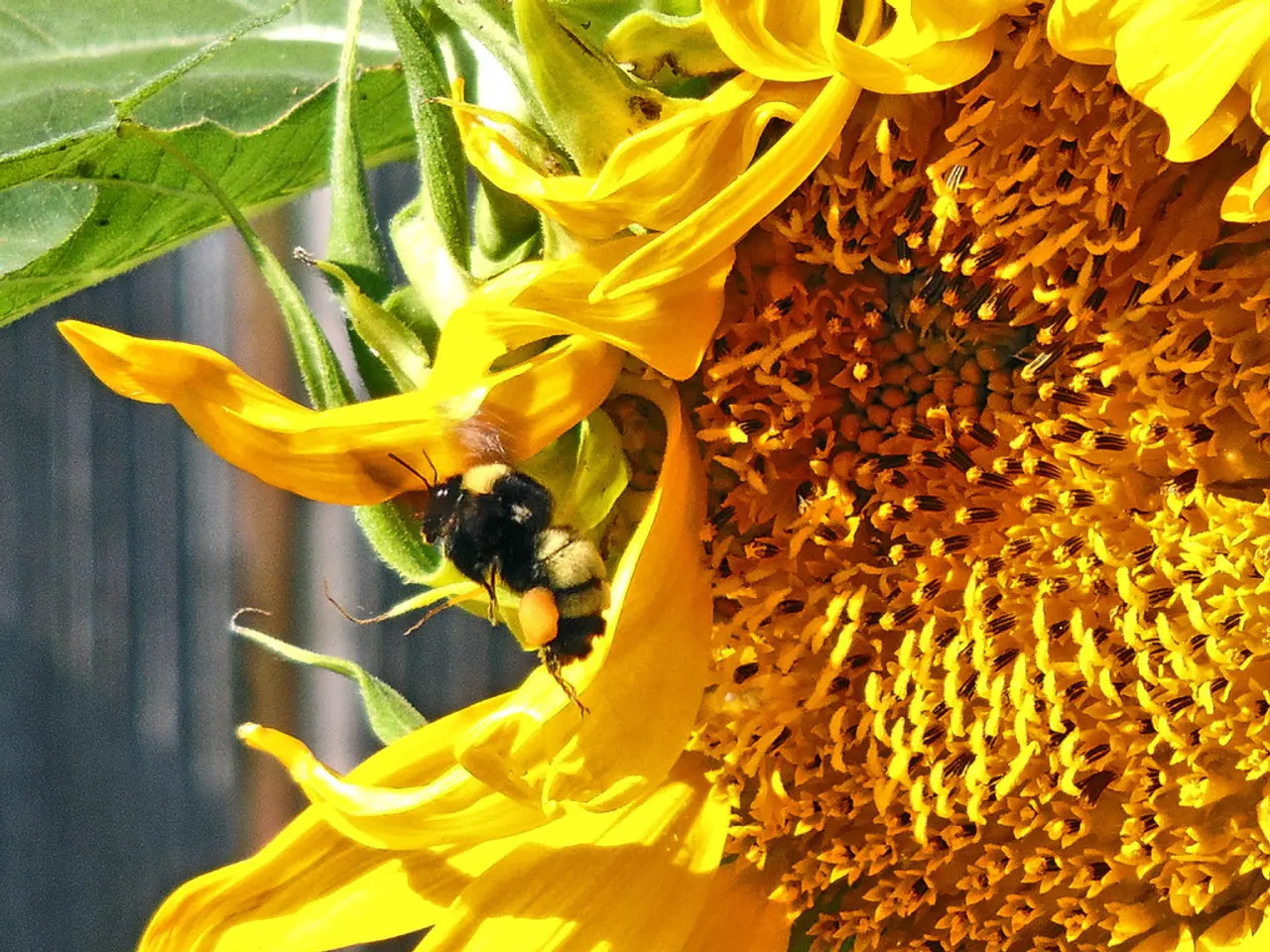Could the honeybee survival predicament be a fabricated concern?
In the United Kingdom, a concerning trend has emerged over the past few decades. Approximately 42% of pollinator species have become less widespread since the 1980s, a fact that underscores the need for immediate action [1]. This decline in pollinator populations has been further compounded by the emergence of various factors, including parasitic varroa mites, climate change, habitat loss, food scarcity, and industry practices [1][2][3].
The year 2007 marked the beginning of widespread reports of mysterious mass disappearances of honeybees, a phenomenon known as Colony Collapse Disorder (CCD) [1]. However, recent research suggests that the current problem with honeybee deaths may be less mysterious than CCD, with early evidence pointing towards a virus transmitted by the Varroa mite as the primary culprit [1].
Despite these challenges, there is some positive news. For instance, another study showed an 85-per-cent increase in honeybee colonies since 1960 [1]. Yet, it's essential to remember that the overall trend for pollinators in the UK, and indeed globally, is downwards [1].
The majority of honeybees live in hives that are artificial nest cavities provided by humans for easy honey harvesting [1]. However, these practices can inadvertently contribute to the decline of wild pollinators, as honey bees—non-native to many areas—can outcompete native pollinators for resources [4].
To support wild pollinators instead, individuals can focus on preserving and restoring natural habitats, planting diverse native flowering plants, reducing pesticide use, and encouraging ecological management practices that favor wild bees [4]. By creating pollinator-friendly environments that mainly support wild bees, we can help maintain biodiversity and ecosystem stability [4]. In areas where honey bees are overly dominant, removing or relocating non-native honey bee colonies might also be considered to give wild pollinators better survival chances [4].
Growing plants that provide nectar and pollen is one of the best things you can do to help wild pollinators [1]. Nectar plant lists are widely available online from organisations like the Wildlife Trusts and the Royal Horticultural Society. Other simple actions include resisting the temptation to mow as much, avoiding pesticides, and leaving areas untamed to help wild pollinators [1].
In recent years, there have been reports of significant losses to honeybee colonies, with up to 70% losses reported by US beekeepers in 2021 [1]. Top US beekeepers are warning of a "death spiral" due to these losses [1].
Over time, people's knowledge of honeybees has evolved from basic facts like they make honey and live in hives. Today, there is a growing recognition and care about pollination due to its importance in food production [1]. If you really want to save the bees, becoming an insect cheerleader rather than a beekeeper might be the way forward [5].
In conclusion, addressing the honeybee crisis requires tackling disease vectors like varroa mites and microbiome disruption, along with broader environmental issues. Supporting wild pollinators involves habitat conservation and planting native flowers while minimising chemical hazards to create a balanced ecosystem for all pollinators [1][2][3][4]. Let's work together to ensure a future where pollinators thrive and our ecosystems remain healthy and diverse.
References: [1] Potts, S. G., et al. (2010). Insect pollinators and food security. Proceedings of the Royal Society B: Biological Sciences, 277(1696), 3035-3042. [2] Kwong, A. W. Y., et al. (2015). The microbiome of the honeybee: an overlooked player in colony health and disease. Trends in Microbiology, 23(3), 142-151. [3] Nuttall, D. A., et al. (2010). Climate change impacts on pollinators: a review of current knowledge, future scenarios, and management options. Journal of Applied Ecology, 47(4), 706-720. [4] Benton, T. G., et al. (2016). The global food crisis: the science and politics of hunger, obesity, and climate change. Springer. [5] Winfree, R., et al. (2019). Beyond bees: the importance of wild pollinators for food security and ecosystem services. Journal of Applied Ecology, 56(3), 783-791.
- The decline in pollinator populations, particularly over the past few decades, has highlighted the urgent need for research in environmental science, aiming to find solutions to disease vectors like varroa mites and microbiome disruptions.
- The current trends in the UK, along with the global situation, show a downwards trajectory for pollinators, emphasizing the need for immediate climate change mitigation strategies in relation to wildlife and the environment.
- The emergence of various factors, such as parasitic varroa mites, climate change, habitat loss, food scarcity, and industry practices, have been linked to the decline in pollinator species and the honeybee crisis.
- To combat the decline of wild pollinators, individuals can focus on lifestyle changes, such as preserving and restoring natural habitats and planting diverse native flowering plants, while also reducing pesticide use and encouraging ecological management practices that favor wild bees.
- Recent research suggests that the current problem with honeybee deaths may not be as mysterious as previously thought, with early evidence indicating that a virus transmitted by the Varroa mite may be the primary culprit.
- While there have been reports of an increase in honeybee colonies since 1960, it's important to remember that the overall trend for pollinators is still downwards, both in the UK and globally.
- In addition to supporting domesticated honeybees, it's crucial to consider the impact of human practices on the survival of native wild pollinators, as honey bees can outcompete native pollinators for resources in areas where they are present.
- In an effort to save the bees and maintain biodiversity, creating pollinator-friendly environments and minimizing chemical hazards is essential in promoting a balanced ecosystem for all pollinators.
- The importance of pollination in food production has gained increased attention in recent years, leading to a growing recognition and care about the role of wild pollinators in the environment, and the need for conservation efforts in entertainment, education-and-self-development, finance, general-news, lifestyle, science, sports, and technology.




